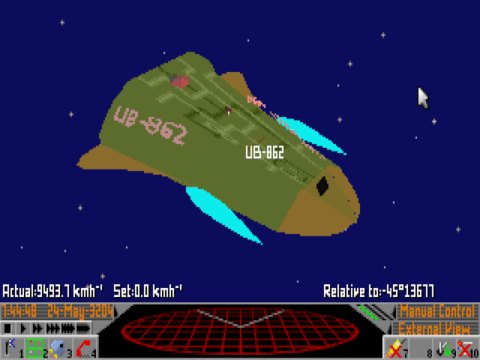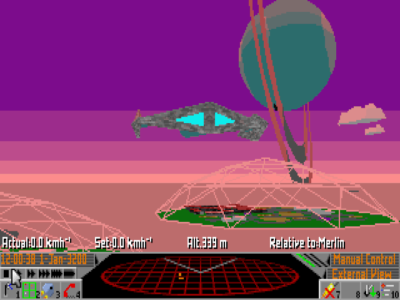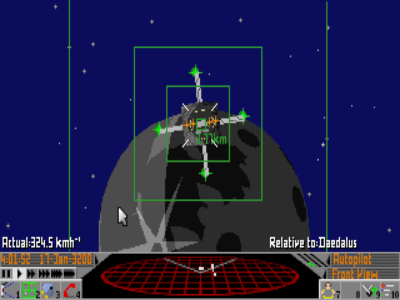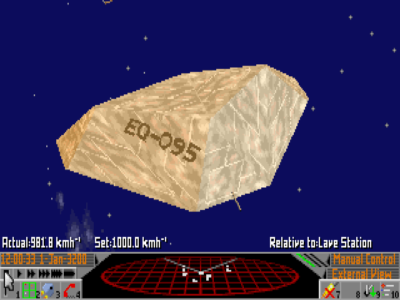
Frontier: Elite 2
Written by: Stoo
Date posted: April 5, 2003
- Genre: Simulation
- Developed by: Frontier Developments
- Published by: Gametek
- Year released: 1993
- Our score: 7
Released in 1984, Ian Bell and David Braben’s Elite was the first great space-sim and a significant step forward in gaming. It was no mere shoot-em-up, the core theme of Elite was profiteering and the pursuit of material wealth. At the helm of a Millennium Falcon style vessel, your aim was buying low and selling high, flying cargo between the stars and finding the best prices. It also featured AI controlled pirates, freighters and police, along with upgrades for your own ship, and a pretty spiffy 3D engine. In short, by the standards of the day it was an amazingly large-scale and complex game; bear in mind this was at the time when Donkey Kong was all the rage in video gaming. Appearing initially on the BBC Micro – a computer known best for its use in schools – Elite was ported to numerous other platforms and become one of the most highly respected titles of the time. It even managed a PC revamp in 1991, essentially the same game but featuring VGA graphics (oooh) and adlib sound (aaah!). However, it was begging for a proper sequel. Not a quick knock-off mind you, but a bigger and better reworking of that space-trading theme.
That arrived in 1993, under the title of Frontier. The concept remains more or less the same: you start off with a tiny, basic ship, a meagre amount of cash, and a desire to make money. There is little structure to the game and no storyline to follow, it’s entirely free-form. It’s up to you where you go and what you do in your pursuit of cash.
Nowadays a game like this can seem to pose a pretty daunting start, especially as there are no in-game tutorials to set you on your way. You’re sat there with your little ship squatting on a landing pad on some backwater planet, unable to purchase anything more than a few tons of grain or metal ore, and wondering exactly how to get started. The danger is that you might take off, fly around randomly for a bit, hit some buttons to see what happens, get lost, shoot at something, get shot at and then triumphantly crash into a space station. Then put the game aside and never look at it again. Which I can sympathise with, as that was pretty much my reaction to the infamous Battlecruiser 3000AD – which if you haven’t heard of, is a similar kind of game. But also a story for another day.
However, the mechanics of trading in Frontier are really pretty simple. Calling up the appropriate screens and maps, look for goods a star system is listed as exporting. These will be on sale cheap, so fly over there and fill your cargo hold. Then find another system that imports the goods. There, they will command a far higher price. So head on over there, and sell your cargo at a profit. In no time you can be watching the cash roll in. Just as long as pirates don’t blast your ship to little bits, anyway.
Aside from buying and selling, there are a number of other means by which to make money. You can operate a taxi service on the side, flying passengers from A to B. Or you can take up mining, buying automated machines and setting them down on uninhabited planets. For those of you with a more violent streak there is the life of a bounty hunter, tracking your victims across space and fragging them in return for cold hard cash. Or if you feel like joining an institution and working up the ladder, the two principle nations in space each have a military. The missions start off seriously dull – ‘take this box of pencils to our base at Achenar and we’ll give you a fiver’ – but success in these leads to more adventurous options such as bombing runs on enemy bases.

That ringed planet isn’t just a backdrop – you can fly over there and orbit it.
So there’s plenty to keep you busy out there. Once you’ve accumulated a decent sum, you can spend it either upgrading your vessel, or buy an entirely new ship. There’s a huge selection on offer, even if many do look like flying wedges, especially those that featured in Elite. They range from tiny and agile fighters, to small couriers and police hunters, up to mid-sized freighters and general-purpose vessels, and finally colossal Clippers that can haul a thousand tons. Bigger is generally better, although not necessarily if you want to get around in a hurry. As for the upgrades there are shields, lasers, scanners and an autopilot. Other options include passenger cabins, heat shielding (essential if you want to land on planets with an atmosphere) and Cargo bay life support (for when you want ship slaves or livestock).
It’s not just gameplay options for which the name of Frontier is spoken respectfully amongst old-school geeks, however. It also stood out for a few technicla innovations, especially regarding rendering of star systems. Usually in these games you see, planets are either just a piece of background scenery, or at best a hazard that you can crash into. In Frontier however they are simulated as full-sized celestial bodies, eternally orbiting their parent star. The game doesn’t load their surfaces as some kind of separate map or environment; the engine is fully seamless. So from one spaceport you can watch moons and planets rise and fall in the sky, and ships coming and going. It has to be said the planets don’t have much detail, away from spaceports, but you can at least cruise over mountains and seas. This kind of realism isn’t essential to a space-sim, but can help make the virtual universe before you a step more convincing.
Taking a moment for an interesting piece of trivia: Frontier was, I believe, one of the very 3D first games to implement coloured lighting. Stars come in shades of blue, red and yellow, and thus when near one you will see everything tinted in the appropriate colour.
Note also that the game generates a truly crazy numer of star systems, each of which you can visit – I think we’re talking millions. In truth though the vastness is a little illusiory, as only a few hundred of the systems have stations to dock at. So the rest are of little interest apart from mining or sightseeing. Still, even if you stick to “inhabited” space that’s still a pretty huge environment. Some systems are prosperous and safe, but in the more lawless regions of space you will have to fight to survive. Also, out in the sticks it’s hard to find well-equipped docking stations should you need upgrades for your ship.
Back to thinking about realism, I should mention the flight model. No ‘WWII fighter combat without gravity or the ground’ here, Frontier makes a hearty stab at how Newtonian mechanics in a vacuum should work. In other words, if you’re flying forwards at constant speed and turn 90 degrees to your left, you’ll still be going in the same direction, but now sideways. If want to change direction you have to apply thrust to alter your velocity vector, and if you’re flying a lumbering great Clipper that might take a while. In fact in realtime it can take hours to get from a standing start (relative to a nearby planet) up to cruising speed, and then another hour or two if you change your mind and decide to go back the way you came. Also, things can tricky when you realise the planet you’re heading towards is half a minute away from you’re still moving at four hundred kilometres a second. Splat!
However, those of us without advanced piloting skills need not fear. Firstly, the autopilot can do all the hard work here, at least when things are quiet. Secondly, there’s an accelerate-time function. So when undisturbed, flying from one destination to another involves little more than setting a destination, hitting go and sitting back.

In tribute to 2001: A Space Odyssey, the Blue Danube plays whenever you dock with a space station.
The bad news is, the realism doesn’t do combat many favours. In fact, it’s a bit tedious and if blasting enemy fighters is your primary interest then you’d be much better served with X-Wing. Fiddling around with thrust vectors can become a pain in the arse, and I normally end up carrying on in a straight line while the ship pivots about like a giant turret. Also, so-called fighters are actually underpowered; although far more manoeuvrable than the big ships their small size restricts them to wimpy weaponry. A much safer option is a big freighter with heavy lasers and lots of shields with which to soak up enemy fire, as you try to get a good shot in.
Aside from that, what else did Frontier not quite get right? Well, trading is arguably too profitable. You can bring in the cash far faster this way than you can by any other means – so there’s less incentive to follow them except as a sideline. If you’ve made a huge profit – and bought the biggest, most well equipped ship – in too short space of time, it can be somewhat unsatisfying. In fact this is a game where a bit of self-discipline is perhaps required to get the best effect, as in forcing yourself to explore and try new and more challenging activities, instead of sticking to shuttling cargo back and forth in the pirate-free core systems.
Also some aspects of the game seem a bit patchy in implementation; for example surface details on a planet can sometimes flicker in and of existence before you. Gravity is a touch half-arsed; you can often fly up a couple of kilometres, turn the engines off and simply hang motionless. The autopilot will occasionally send you crashing into solid objects. Some ship-to-ship communications options seem entirely useless. Not game-killing issues, just examples of how the game can feel a bit rough and unpolished. Oh and one final nitpick – for some odd reason space is a shade of deep blue.
I could think of further opportunities for improvement, but these are more features I would want to see in a game today, than ones I would criticise a game from 1992 for lacking. For example, the ability to own more than one ship at a time, and fly one yourself whilst you send the others off trading or escorting freighters. Also buying and running your own factories and stations. Both of these have since been implemented by X – Beyond the Frontier. Despite the name it’s no official relation to Frontier but carries on in the same spirit and the sequel, X2 is generally regarded as the current king of the space-traders.
There’s no doubt that Frontier has been outclassed in many aspects. Without options to expand your business ventures to a larger scale, the game has pretty much shown you all it has to offer once you have millions of credits and the biggest ship. That is, unless you want to go exploring for the hell of it, or pursue a higher combat rating. Still, Frontier continues to appeal as an example of ‘open’ gaming. There’s enough to keep a space him happy for hours, be it hunting, trading, or just filling the hold with fuel and setting out to explore. Even though it’s twelve years old, and fits onto a single floppy disk, there’s a hell of a lot of gaming there. Also the seamless star systems have yet to be replicated by any of the more modern titles.

The Cobra mkIII was your ship back in the original Elite.
When it comes to a game this old, you can be forgiven for wondering if our enthusiasm is entirely rational, or just nostalgia talking. Well, I can’t deny I have fond memories of time wasted on this one at age 13. Still, we like to think we take a pretty honest approach to the oldies here. It might be harder for something released over a decade ago to appeal when up against modern titles, but there are some gems that continue to shine; The Monkey Islands and the Mario Worlds. Frontier might have been knocked off its throne at the top of the space-trader subgenre, but is definitely amongst those worthy examples of the best of the old days. I might even say the ‘elite’ but we try to rise above bad puns here.


 Posts
Posts